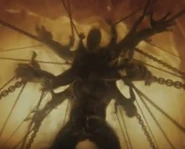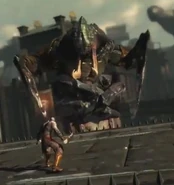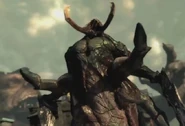No edit summary |
|||
| Line 18: | Line 18: | ||
'''Aegaeon '''is one of the''' '''three''' [[Hecatonchires]]''' and the first boss in God of War: Ascension. He was the first to be punished by the furies and became a titan sized prison of the living damned, like Kratos who is imprisoned in the Hekantinkheires by [http://godofwar.wikia.com/wiki/The_Furies The Furies], as punishment for his crimes in [http://godofwar.wikia.com/wiki/God_of_War:_Ascension God of War: Ascension]. |
'''Aegaeon '''is one of the''' '''three''' [[Hecatonchires]]''' and the first boss in God of War: Ascension. He was the first to be punished by the furies and became a titan sized prison of the living damned, like Kratos who is imprisoned in the Hekantinkheires by [http://godofwar.wikia.com/wiki/The_Furies The Furies], as punishment for his crimes in [http://godofwar.wikia.com/wiki/God_of_War:_Ascension God of War: Ascension]. |
||
==Greek Mythology== |
==Greek Mythology== |
||
| − | '''Aegaeon''' (also called '''Briareus''') the [[Hecatonchires]] was one of three giants of incredible strength and ferocity that surpassed that of all [http://godofwar.wikia.com/wiki/Titans Titans] whom they helped overthrow. Born from [[Gaia]] and [[Ouranos]], along with his two brothers '''Cottus''', and [[Gyges|Gyges.]] Their name derives from the Greek ἑκατόν (''hekaton''; "hundred") and χείρ (''kheir''; "hand"), "each of them having a hundred hands and fifty heads". Hesiod's ''Theogony'' reports that the three Hekatonkheires became the guards of the gates of [http://godofwar.wikia.com/wiki/Tartarus Tartarus]. |
+ | '''Aegaeon''' (also called '''Briareus''') the [[Hecatonchires]] was one of three giants of incredible strength and ferocity that surpassed that of all [http://godofwar.wikia.com/wiki/Titans Titans] whom they helped overthrow. Born from [[Gaia]] and [[Ouranos]], along with his two brothers '''Cottus''', and [[Gyges|Gyges.]] Their name derives from the Greek ἑκατόν (''hekaton''; "hundred") and χείρ (''kheir''; "hand"), "each of them having a hundred hands and fifty heads". Hesiod's ''Theogony'' reports that the three Hekatonkheires became the guards of the gates of [http://godofwar.wikia.com/wiki/Tartarus Tartarus]. Different accounts claim unlike the other Heconchires, Aegaeon fought along the side of the Titans and not the [[Gods]] in the [[Titanomachy]]. Making Aegaeon one of the assailants of [[Olympus]], who, after his defeat, was buried under Mount Aetna. |
==In God of War Series== |
==In God of War Series== |
||
Revision as of 20:08, 3 February 2013
Template:Infobox gods
| “ | ...the Furies felt death was too kind for this oath breaker, Aegaeon, the Hecatonchires became an example to all. | ” |
–Gaia. | ||
Aegaeon is one of the three Hecatonchires and the first boss in God of War: Ascension. He was the first to be punished by the furies and became a titan sized prison of the living damned, like Kratos who is imprisoned in the Hekantinkheires by The Furies, as punishment for his crimes in God of War: Ascension.
Greek Mythology
Aegaeon (also called Briareus) the Hecatonchires was one of three giants of incredible strength and ferocity that surpassed that of all Titans whom they helped overthrow. Born from Gaia and Ouranos, along with his two brothers Cottus, and Gyges. Their name derives from the Greek ἑκατόν (hekaton; "hundred") and χείρ (kheir; "hand"), "each of them having a hundred hands and fifty heads". Hesiod's Theogony reports that the three Hekatonkheires became the guards of the gates of Tartarus. Different accounts claim unlike the other Heconchires, Aegaeon fought along the side of the Titans and not the Gods in the Titanomachy. Making Aegaeon one of the assailants of Olympus, who, after his defeat, was buried under Mount Aetna.
In God of War Series
After the Great War, Aegaeon plegded a blood oath to Zeus, only to later betray him. The Furies weren't pleased by this betrayal and thus hunted him down, to torture him without end as they saw death would be too merciful for such a crime. He became an example to all, and a prison for those who followed his example.
Six months after he was tricked into killing his wife and child, a younger Kratos finally finds a way to break the blood oath that binds him to the God of War, Ares. After taking matters into his own hands, Kratos is sentenced to a life of madness with the Furies, caged in a Titan sized prison for the living damned; Hekatonkheires. As he escaped the torture of Megaera, he chased her in an attempt to find the exit of this damned place, only to be attacked by her minions and later by the prison itself. The parasites used by Megaera enter an arm of the Hekatonkheires, which causes the fingers to mutate and grow, moments later a monster with giant tusks bursts out the palm of the hand, using the four remaining fingers (the two in the middle are turned to his back), become his claws. During this first confrontation, the environment changes, similar as it did during the first boss battle in God of War III. Kratos ended this battle by slitting the monster's throat with it's own claw. During a second battle an arm splits in half to reveal a monster similar to the first monster. It uses the two halves of Hekantonkheir's hand as claws. The monster throws Kratos through several prison cells before continueing the battle. During the battle, Kratos weakens the monster by letting a part of the prison crashing down it twice before pinning his hands and chest to three spikes, one each, before snapping it's back.
Trivia
- The other name for Aegaeon is Briareus (which he is often called), the Hecatonchire Kratos faces in God of War: Ascension goes by the name Aegaeon.
- In Greek mythology, the Hecatonchires are said to be three hundred-handed giants that kept the Titans imprisoned, in the God of War series, however, the Hecatonchires is a Titan sized prison built in the body of Aegaeon, one of the three brothers.
- Gyges, one of the Hecatonchires, appears in the God of War Comics.
- Megaera turns two of Aegaeon's smaller arms into insect-like monsters by using the parasites that come out of her chest; they look similar to beetles as they have the same type of tusks and also have plating like a scorpion's.



